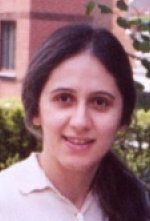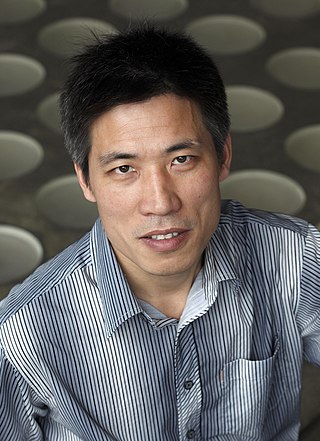
Chemical vapor deposition (CVD) is a vacuum deposition method used to produce high-quality, and high-performance, solid materials. The process is often used in the semiconductor industry to produce thin films.
Solid-state chemistry, also sometimes referred as materials chemistry, is the study of the synthesis, structure, and properties of solid phase materials. It therefore has a strong overlap with solid-state physics, mineralogy, crystallography, ceramics, metallurgy, thermodynamics, materials science and electronics with a focus on the synthesis of novel materials and their characterization. A diverse range of synthetic techniques, such as the ceramic method and chemical vapour depostion, make solid-state materials. Solids can be classified as crystalline or amorphous on basis of the nature of order present in the arrangement of their constituent particles. Their elemental compositions, microstructures, and physical properties can be characterized through a variety of analytical methods.
Richard John Puddephatt, was born 1943 in Aylesbury, England. He is a distinguished university professor in the department of chemistry at the University of Western Ontario, in London, Ontario, Canada. Richard is a former holder of a Canada research chair in material synthesis. He has been studying the fundamental chemistry of gold and other precious metals in the development of new materials for potential applications in health care and electronics. Puddephatt's research interests involve organometallic chemistry related to catalysis and materials science, and he is considered a world expert on platinum and gold chemistry. He has authored two books: The Chemistry of Gold and The Periodic Table of Elements.

Transparent conducting films (TCFs) are thin films of optically transparent and electrically conductive material. They are an important component in a number of electronic devices including liquid-crystal displays, OLEDs, touchscreens and photovoltaics. While indium tin oxide (ITO) is the most widely used, alternatives include wider-spectrum transparent conductive oxides (TCOs), conductive polymers, metal grids and random metallic networks, carbon nanotubes (CNT), graphene, nanowire meshes and ultra thin metal films.

Tantalum(V) ethoxide is a metalorganic compound with formula Ta2(OC2H5)10, often abbreviated as Ta2(OEt)10. It is a colorless solid that dissolves in some organic solvents but hydrolyzes readily. It is used to prepare films of tantalum(V) oxide.
Barium acetylacetonate is a compound with formula Ba(C5H7O2)2. It is the Ba2+ complex of the anion acetylacetonate. The compound is typically encountered as an ill-defined hydrate, which would accord with the high coordination number characteristic of barium.

Polly Louise Arnold is director of the chemical sciences division at Lawrence Berkeley National Laboratory and professor of chemistry at the University of California, Berkeley. She previously held the Crum Brown chair in the School of Chemistry, University of Edinburgh from 2007 to 2019 and an Engineering and Physical Sciences Research Council (EPSRC) career fellowship.

John Paul Attfield is a Professor of Materials science in the School of Chemistry at the University of Edinburgh and Director of the Centre for Science at Extreme Conditions (CSEC).

Benjamin Guy Davis is Professor of Chemical biology in the Department of Pharmacology and a member of the Faculty in the Department of Chemistry at the University of Oxford and a Fellow of Pembroke College, Oxford. He holds the role of Science Director for Next Generation Chemistry (2019-2024) and Deputy Director (2020-) at the Rosalind Franklin Institute.

Roger Arthur Sheldon is emeritus professor of Biocatalysis and Organic Chemistry at Delft University of Technology in the Netherlands.

Paul O'Brien was professor of Inorganic Materials at the University of Manchester. where he served as head of the School of Chemistry from 2004 to 2009 and head of the School of Materials from 2011 to 2015. He died on 16 October 2018 at the age of 64.
Syed Tajammul Hussain (PP), was a prominent Pakistani chemist and physicist, one of the pioneers of nano-technology in the country, known for his important contributions to the field of nanomaterial-based catalysts. He is also known for his role in laying down the foundations of nanotechnology in Pakistan and a new method for production of diesel fuel from coal, catalyzed by nano-particles.

James Robert DurrantFRSC FLSW is a British photochemist. He is a professor of photochemistry at Imperial College London and Sêr Cymru Solar Professor at Swansea University. He serves as director of the centre for plastic electronics (CPE).

Sarah (Sally) Lois Price is Professor of Physical Chemistry at University College London.
Helen H. Fielding is a Professor of physical chemistry at University College London (UCL). She focuses on ultrafast transient spectroscopy of protein chromophores and molecules. She was the first woman to win the Royal Society of Chemistry (RSC) Harrison-Meldola Memorial Prize (1996) and Marlow Award (2001).

Taraneh Javanbakht is an Iranian-Canadian scientist and polymath.

Gilbert Daniel Nessim is a chemistry professor at Bar-Ilan University specializing in the synthesis of 1D and 2D nanomaterials for electronic, mechanic, and energy applications.

Junwang Tang, MAE, FRSC and FIMMM, is the Founding Director of Industrial Catalysis Center, and Carbon Neutrality Chair Professor of Materials Chemistry and Catalysis at the Department of Chemical Engineering, Tsinghua University and Visiting Professor at University College London (UCL). He also served as the Director of the University Material Hub at UCL (2016–2019).
Bismuth phosphide is a proposed inorganic compound with the chemical formula BiP. The structure of this material is unknown.












